Share on facebook
Share on pinterest
Share on twitter
https://youtu.be/3VZvq9rU6cE
Air Conditioners Buyers Guide: You surely don’t want to buy an air conditioner that won’t last long or could raise your electricity bills by a huge amount? Here’s a list of things that’ll help you figure out what should matter and help you find the perfect AC for your needs!
At this stage, we are more or less sure that you know much more about how an air conditioner works than a salesperson ever will. Time has come for you to learn about the small print that carries important information about an air conditioner.
Buying an AC in India is a tidy investment. Most of them are the second most expensive thing you will buy, after a car. In this section of the article, we attempt to demystify the art of buying an air conditioner.
At a typical shopping mall or mega electronics store, the salespeople are remarkably pushy and will throw around jargon with no meaning, such as “grooved copper coil”, “R-32 gas” which makes little sense to someone who is not an engineer.
Mode

A modern air conditioner can operate in various modes as under.

Cool Mode: The usual mode where the air conditioner cools the room to the preset temperature. Suppose on a hot day you have set it to 23°C and turned it on. The machine will cool the air till it reaches 23°C and maintains it close to that temperature.

Power Cool/Chill Mode: Newer ACs have this feature. When you first turn it on regardless of what temperature you have set it at, the AC cools at 100% capacity as if cooling for 16°C. As the room grows cooler it gives up this mode and reverts to normal Cool Mode mentioned above.

Dry Mode: In the dry mode, the air conditioner removes excess humidity and is used mostly during monsoons. The fan is on constantly at low speeds and the compressor works in short bursts. The air conditioner in effect works as a dehumidifier.

Power Save Mode: This is an extension of the Cool Mode but even the fan switches off to save electricity. When the air heats the fan switches on first and cools the room slightly. When the air warms up further the compressor switches on.

Sleep Mode: This is the most ingenious mode and details vary slightly across brands. It increases the temperature by 1°C every hour for two hours and then switches the air conditioner off after 6 hours.
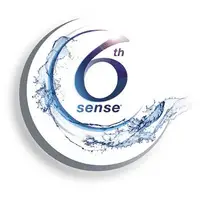
6th Sense: The proprietary technology of Whirlpool air conditioners which can adjust the fan speed depending on the room temperature.
Tonnage
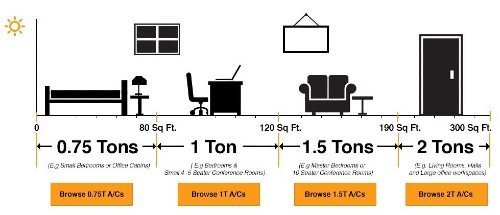
1 Ton here implies the amount of heat required to melt a ton of ice in a day (which happens to be 288,000 British Thermal Units or BTU).
A one-ton AC takes away 288,000/24 = 12,000 BTU of heat from your room in an hour and a two-ton AC takes away double that or 24,000 BTU in an hour and so on.
But much depends on ambient temperature if the surrounding air. In Indian conditions, it is considered that a one-ton AC can cool a small room (10 ft by 10 ft) with 2 people in it and a 1.5 ton AC can cool a larger room 12 ft by 13ft with 4 people in it satisfactorily from 35°C to 22° C. Most large office rooms (80 ft by 100 ft) use ten 2 ton AC units.
In colder climates, the tonnage needed is much less. In Germany where average summer temperature is about 25° C you would need half the tonnage to take the temperature down to a comfortable 19° C (of course in such a climate, heating that is more important for most of the year).
Factors that affecting tonnage
The temperature of the city – A place like Jaipur where the summer peak reaches 45° C would require much more tonnage than say Shimla or Ooty.
The volume of the room – The bigger the room, the more is the volume of air that needs to be cooled and kept cool. This affects tonnage.
The quantity of furniture and fittings – Heat is trapped not only in the air but also in things inside the room. An empty room requires less tonnage. A room chock full of carpets and sofas needs more cooling.
Also, the presence of a desktop computer can make the room dramatically warmer. That is why you will find bank branches are never very cold even though a dozen air conditioners are running.
It is also important to note that apartments on the topmost floor are far hotter than those below. This is because they not only become hot due to warm air. But also heat transfer by conduction from the roof.
Any flat on the top floor will need a larger AC. If you just wish for a summary. Then for an average room a 1.5 ton AC is sufficient and a 2 ton AC is more than enough. For small rooms, guest bedrooms, doctor’s chamber, small shops a one-ton AC is enough.
Compressor Types
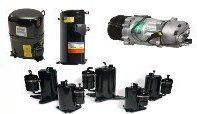
This is a hugely important piece of technology since the compressor is the engine of your AC unit. The compressors in use till a decade back used a piston.
There is an inlet valve through which gas entered the piston cylinder (much in the same way as a car cylinder) and the piston would push the gas into a more confined space thus compressing it into a liquid.
In the case of a rotary compressor, it is the force generated by a screw shape that creates the pressure (much like the water pump at your home).
The chief advantage of a piston-type or reciprocating compressor is that it is slightly more efficient (since it pushes) than a rotary compressor (which in effect squeezes).
But a rotary compressor has a lesser number of moving parts, which means a fewer number of components which can fail, less maintenance, greater durability. This is why rotary compressor AC’s are preferred in homes and small offices.
Inverter And Non-Inverter Technology
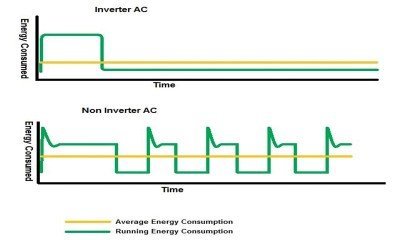
Probably many of the ACs you see around you have a non-inverter compressor (though they are on the whole on the way out).
The sole problem is they are binary – either on or off. This means they cannot step down their performance once the room is cool.
What does it mean in real terms? The room has to be allowed to warm once it is cool and the compressor will again work and take away the heat.
This is sort of a wave with highs and lows of temperature throughout the day. Ideally should not an AC maintain more or less the same temperature it is preset to?
This is what happens with an inverter compressor. Instead of switching off when a temperature is reached it just idles down a bit. An inverter compressor continues to work but at a slower pace.
An inverter compressor is designed to work at speeds from 1100 to 4500 rpm (revolutions per minute). It never switches off unless the AC unit power is switched off.
The real advantages of inverter compressor
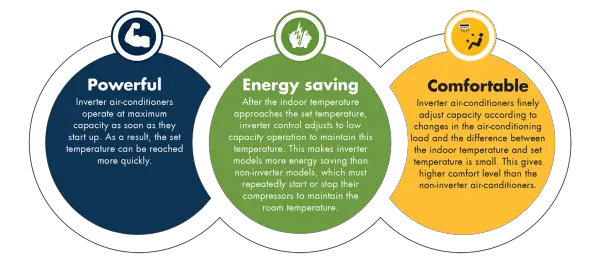
More stable cooling- The temperature is consistently maintained. This is much more comfortable and efficient. The compressor monitors the temperature level and steps up rpm if needed by 30% or steps it down. This is a vastly more efficient way of cooling.
Less consumption of electricity- A linear compressor has to bring down the temperature every time. This needs more energy and a larger payout in the form of electricity bills. With the introduction of inverter compressors, there is a 30 to 50% drop in electricity bills.
More durable- Starting and stopping a device causes it to grow warm and cold. This heating and cooling affect durability. Have you noticed how your ceiling fan rarely breaks down though it seldom gets any rest?
That is because it is in a constant state. Change of state affects durability. Inverter compressors are better since they constantly run.
Less electricity is needed- The mechanism of the inverter compressor needs less energy though they work longer. Pushing gas out by the use of centrifugal force is a much more efficient way of pumping gas than using a piston.
Less noise- Just like a car engine, a piston is noisier since it has more moving parts. An inverter compressor has a less number of moving parts and is quiet. In this era of expensive energy who will not want to save more on a machine.
That is going to run several hours a day for many years. Even if at a minimum you save one-two units a day during summer. That works out to several thousand rupees.Over 8-10 year life of an air conditioner. In actuality, you save far more.
Coil Material
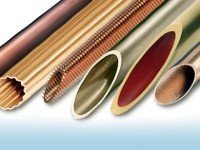
We have all seen the snaking coil at the back of a window air conditioner. It is like the veins of the body through which blood flows and the refrigerant is the blood.
The body is only as strong as the blood vessels and an air conditioner is only as good as the coils that make it. At the very beginning of this part of the guide, I had stated that an AC is nothing more than a very long metal tube filled with refrigerant gas.
There are two types of metals in use for air conditioning – copper and aluminum (usually some type of aluminum alloy). Copper is far better than aluminum and alloy materials when it comes to condenser coils. A condenser coil needs to be able to pass heat quickly from the liquefied gas to the air outside.
Why then do manufacturers use aluminum in some models. The reason is the cost. Copper is at this moment three times more expensive.
In an era of cost-cutting, it is important to save every penny from a manufacturer’s point of view and the low cost of aluminum is attractive.
Not only is copper better at heat exchange but it is more resistant to corrosion. The corrosion of copper happens slowly and can be avoided by regular maintenance every year.
Aluminum corrosion cannot be defended against so easily and there is bound to be fatigue and wear at the site of corrosion.
A leak in the copper coil can be repaired. However, it is far more difficult to weld or solder aluminum.
That is why with any leak the entire coil subsystem has to be changed. If you can afford to always choose an air conditioner with copper tubing. It will last longer and seldom fail if it is cleaned periodically.
Star Ratings
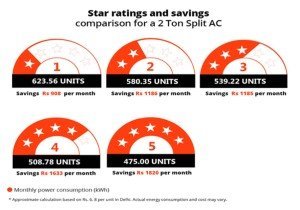
It is the most mystifying of all the criteria. It is also the criteria where the most numbers of misstatements occur by those trying to sell you an AC.
The Star Rating for energy efficiency that has been developed by BEE (Bureau of Energy Efficiency).
Note that the BEE ratings do not only apply to an AC but refrigerators, bulbs and a variety of energy-intensive appliances. Since televisions consume no more than 50 watts they are as yet not sold by the BEE rating criteria.
The ratings have been developed to help a consumer understand how energy efficient a product is. This is important because you would be spending a vast sum of money to run a machine that is not very efficient.
If somehow I could bring to you a 20-year old air conditioner in a brand new box packed condition and sell it to you for only a thousand rupees do you think that would be cheaper than a modern AC which would cost you 30 times more?
Not really since that old design air conditioner consumes about 15 units of electricity every night and the new models spend no more than 2-3 units.
In about 18 months running the electricity bill. Would be large enough for you to have bought the new model AC. (10 units a night means 5000 units over 18 months which is about the cost of a new model AC).
Types of Refrigerants

The coolant gas is, of course, a very crucial part of an AC system. It is responsible for absorbing heat from the room and transferring it outside.
It is repeatedly liquefied by the compressor and loses heat. In the condenser coils and then released into the evaporator coil by the expansion valve.
This happens hundreds of times an hour and the nature of the gas. As well as its ability to exchange heat is all-important.
In the section “How Does An AC Work” the process has been discussed in detail. Let us take a look at the various types of refrigerant gases.
CFC Refrigerants
These gases were discovered in the late 40s and are harmful to the ozone layer. CFC gases are no longer used in any air conditioning system from 1995.
But if there is an existing system from that time it is still using CFC. R-11 (Trichlorofluoromethane) and R-12 (Dichlorodifluoromethane) were some of the more popular CFC gases in use.
HCFC Refrigerants
These were halogenated CFC gases such as R-22 and R-123 having either methane or ethane combined with chlorine and fluorine. They are considered as a medium-term solution while more research takes place.
In 2015 production of HCFC was stopped and by 2020 there will be a ban in place, about their use in new air conditioning systems. They are better than CFC but still harm the environment.
HFC Refrigerants
These gases such as R-134A and R-125 contain hydrogen, fluorine, and carbon. There is no presence of chlorine and this makes it safe for the environment.
Though they are safe for the ozone layer, they do cause global warming and HFC gas. Use will be much reduced in the future, though there is no plan to ban it as yet.
HC Refrigerants
Hydrocarbon Refrigerants are non-toxic and do not deplete the ozone layer. A hydrocarbon refers to any compound of hydrogen and carbon such as paraffin but some gaseous hydrocarbons like methane and propane act well as refrigerants and are better than CFC gases at heat transfer.
Isobutane (R-600A) is found in freezers and propane (R-290) is used in air conditioning.
Warranty Period

A couple of brands offer a 10-year warranty on the compressor including gas replacement. This is something worthwhile and needs to be looked at since a compressor is the heart of an AC.
An assurance that you will not need to incur any cost on its replacement for a decade is going to add to the pleasure of buying.
But at the same time make sure of what exactly the warranty covers. Very often companies will claim that the damage in the compressor has extended. To the piping and they are unable to fix a new compressor since the piping needs to be replaced.
Also, some companies have a more customer-friendly attitude and some try to wiggle their way out of a commitment. Before buying a model search for it on the internet and read the reviews (both positive and negative).
The nature of a company can often be understood through what a dozen or hundred reviews say. This is not to say that reviews tell the complete truth but they do give an impression.
It is also crucial to know if you can install the AC using local workmen. Some companies do not honor the warranty if an AC is installed by unauthorized personnel. But in most cases, local workmen give quicker install and charge less.
Buying an AC has several factors accompanying it. I have tried to give you a bird’s eye view of every topic without going into extreme detail. Hopefully, the information that you have gleaned from the above.
Beginning with how an AC works, what are its different parts, what is an inverter compressor, energy rating. And advantages of the copper coil will stand you in good stead when the buying decision arrives.
Price & After Sales Service

An air conditioner is a pricey thing. Also, they cannot be repaired very easily or even if repaired they can never go back to optimal factory settings and cool very efficiently.
Hence the price is an important factor. Although the AmazonBasics model given above costs less, the usual 1.5 ton split inverter AC prices start at about INR 34,000.
The price of some brands such as Carrier and Hitachi is more due to the excellent quality of products and goodwill.
But that is no guarantee that those expensive machines will not fail. Very often when an AC fails the entire subsystem has to be changed. Such as if the compressor is leaking, the compressor and a large part of the evaporator coils may need a change.
Also due to rapid changes in BEE standards, an AC no longer needs to last 20 years. A life of 10 years is what must be looked at considering that they have almost no resale value.
Brands such as Voltas and Samsung have a vast after-sales network. It is not something completely irrelevant when buying an AC.
Make a Google search for the number of service centers in your city of every brand. Since no brand will have more than 2-3 you could even. Call a few to find how quickly they can send over a technician to check how fast they will react when you need them.
Brands such as Carrier have very few service centers. This is a definite negative at times unless you happen to live in a large metro.
Thanks for reading that far we hope this article of. “Air Conditioners Buyers Guide” will help you to find the best air conditioners for this 2020’s summer.
Here, the Top 10 Best Air Conditioners for you to consider.
